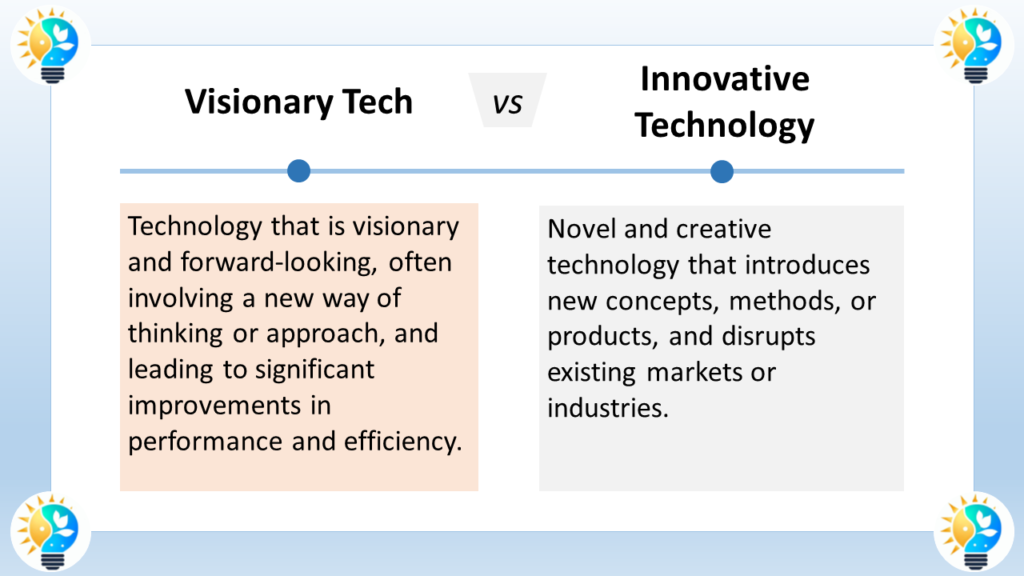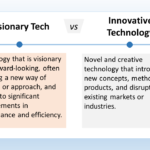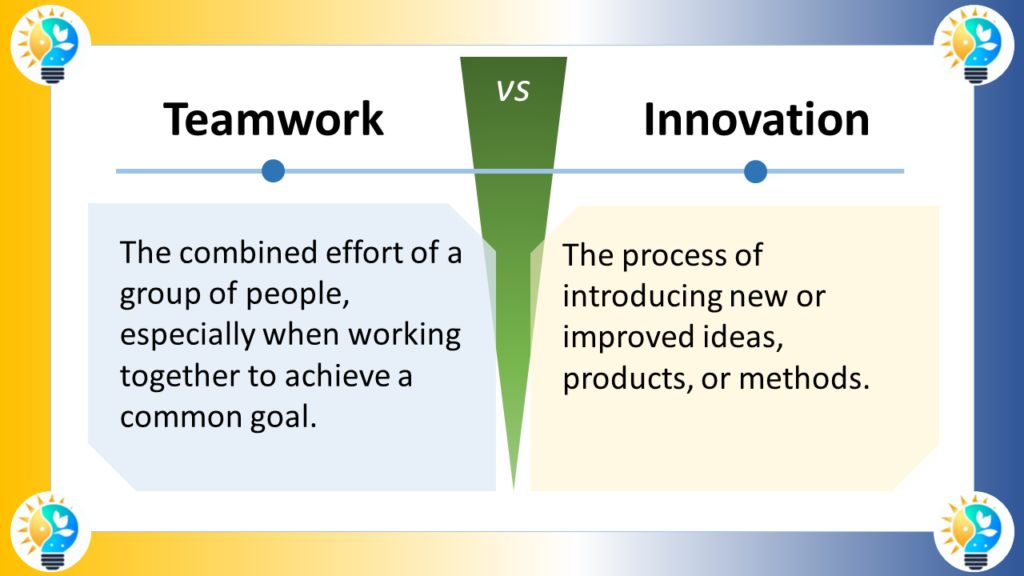Visionary tech and innovative technology both signify forward-looking advancements, but while visionary tech emphasizes a futuristic outlook, innovative technology actively introduces new concepts or products to achieve efficiency gains.

In the ever-evolving tech landscape, Innovative Technology and Visionary Tech represent different facets of progress. Both are forward-looking, but they differ in scope, application, and the magnitude of their aspirations.
Definition
Defining Innovative Technology
Innovative Technology refers to the development of new products or improvements on existing ones that introduce a significant change, offering better performance, functionality, or efficiency. It’s about practical and implementable advancements that are within reach and have a clear path to application.
Characteristics of Innovative Technology
- Incremental: Focuses on step-by-step improvements.
- Feasible: Grounded in current technological capabilities.
- Accessible: Generally available or soon to be available to the public or industry.
Defining Visionary Tech
Visionary Tech, by contrast, is characterized by its radical and often groundbreaking nature. This type of technology embodies bold ideas that may still be years or decades away from practical implementation. It’s the kind of tech that aims to bring about paradigm shifts and fundamentally alter how we interact with the world.
Characteristics of Visionary Tech
- Futuristic: Represents ideas that are ahead of their time.
- Disruptive: Has the potential to disrupt current technologies and industries.
- Ambitious: Involves a high level of ambition and imagination.
Exploring a Variety of Synonyms for Innovative Technology
- Advanced Technology
- Cutting-Edge Innovations
- Cutting-Edge Breakthroughs
- Disruptive Tech
- Emerging Technologies
- Forward-Looking Tech
- Futuristic Innovations
- Groundbreaking Developments
- High-Tech Breakthroughs
- Innovative Breakthroughs
- Inventive Solutions
- Leading-Edge Advancements
- Modern Technological Breakthroughs
- Progressive Advancements
- Next-Generation Technology
- Novel Tech
- Revolutionary Tech
- State-of-the-Art Solutions
- State-of-the-Art Innovations
- Trailblazing Innovations
- Visionary Tech

Innovation is considered as a driving force in progress.
It includes the introduction of novel ideas, methods, or products that bring positive change and advancement.
For more information about innovations, check our glossary
Innovative Technology vs. Visionary Tech: Relationship and Relevance
Innovative Technology is essential for continuous improvement and keeping pace with the evolving demands of society. Visionary Tech, while not always immediately actionable, inspires the direction of future innovations and challenges the status quo.
Contextual Use of the Terms
Companies apply Innovative Technology to refine their products and services, ensuring competitiveness and meeting the current market demands. Visionary Tech, on the other hand, is often the domain of research labs and think tanks where ideas are nurtured that could revolutionize industries in the long term.
Examples of Utilization
The use of OLED screens in smartphones is an example of Innovative Technology, enhancing display quality with better colors and contrast compared to previous LCD technologies.
In contrast, the concept of a space elevator, a theoretical structure reaching into outer space to transport materials and possibly humans, is an example of Visionary Tech—it’s a bold idea that would completely change space travel but remains a concept due to current technological and material limitations.
Comparison Innovative Technology vs Visionary Tech
Innovative Technology and Visionary Tech are two related but distinct concepts in the realm of technological advancements. While both involve pushing the boundaries of what is possible, they differ in their focus and approach. Here is a breakdown of the difference between Innovative Technology and Visionary Tech:
Innovative Technology:
- Definition: Innovative Technology refers to the development and implementation of new or improved technologies that bring about significant advancements or improvements in various fields.
- Characteristics:
- Novelty: Innovative technologies are characterized by their novelty and uniqueness. They introduce new ideas, concepts, or approaches that have not been widely used or seen before.
- Practicality: Innovative technologies are designed to address specific problems or needs and provide practical solutions that improve efficiency, effectiveness, or user experience.
- Incremental Improvements: Innovative technologies often build upon existing technologies, making incremental improvements or enhancements to existing systems or processes.
- Market Adoption: Innovative technologies aim to gain market acceptance and widespread adoption by offering tangible benefits and advantages over existing solutions.
- Examples: Examples of innovative technologies include new smartphone features, advanced medical devices, renewable energy solutions, and cutting-edge software applications.
Visionary Tech:
- Definition: Visionary Tech refers to technological advancements driven by visionary individuals who possess a unique perspective and the ability to envision and shape the future of their respective fields.
- Characteristics:
- Paradigm Shifts: Visionary tech often leads to paradigm shifts, challenging existing norms and pushing the boundaries of what is possible. It involves thinking beyond incremental improvements and envisioning entirely new possibilities.
- Interdisciplinary Approach: Visionary tech often emerges at the intersection of diverse disciplines, combining insights and knowledge from various fields to create groundbreaking innovations.
- Disruption: Visionary tech disrupts existing systems, processes, or industries by introducing transformative ideas, technologies, or business models that revolutionize the way things are done.
- Long-term Impact: Visionary tech aims to have a lasting impact on society, shaping the future and driving significant changes in how we live, work, and interact.
- Examples: Examples of visionary tech include the development of artificial intelligence, blockchain technology, space exploration and colonization, and advancements in genetic engineering.
FAQ
Q: Are visionary tech ideas always realized?
A: Not all Visionary Tech ideas come to fruition; they often face significant technical, financial, or practical hurdles that must be overcome to be realized.
Q: How important is visionary tech to the tech industry?
A: Extremely important. Visionary Tech sets long-term goals and directions that can drive the industry’s research and development efforts.
Q: Can innovative technology evolve into visionary tech?
A: Yes, what starts as Innovative Technology can evolve into Visionary Tech as its implications and potential future applications are fully realized.
Q: Why do companies invest in visionary tech if it’s not immediately profitable?
A: Investing in Visionary Tech can position a company as a leader in future markets and technologies. It’s a long-term strategy that could yield significant competitive advantages.
Q: How do consumers contribute to the development of visionary tech?
A: Consumer interest and demand can influence the focus and direction of Visionary Tech development. Public and market responses can drive investment and innovation in certain visionary ideas over others.


